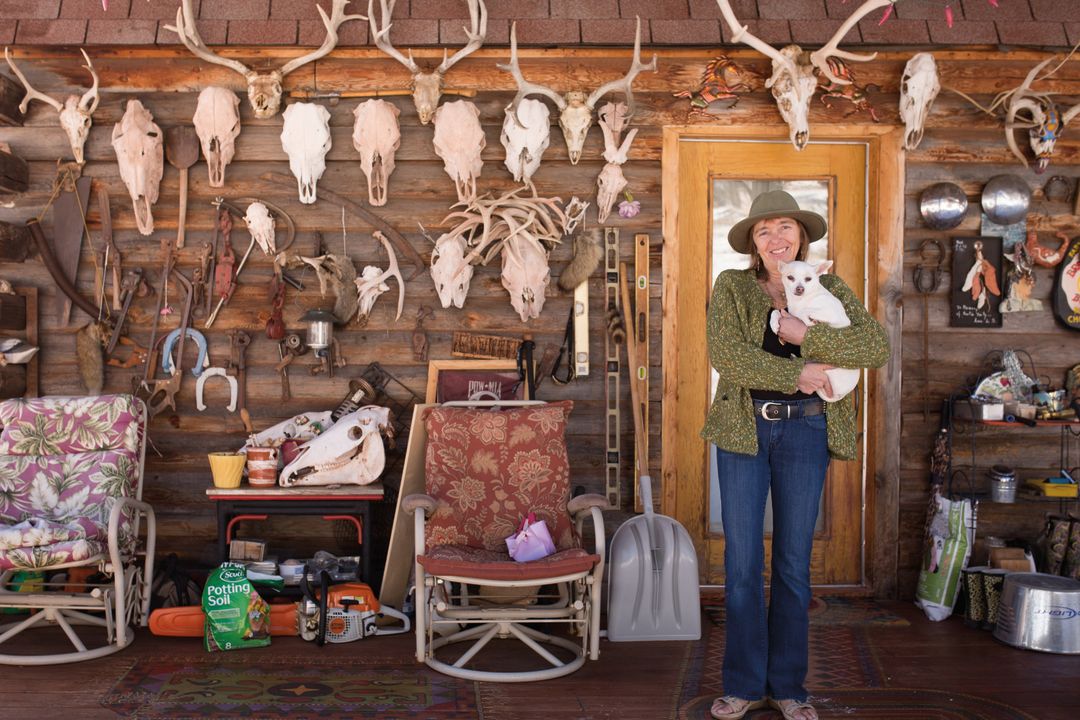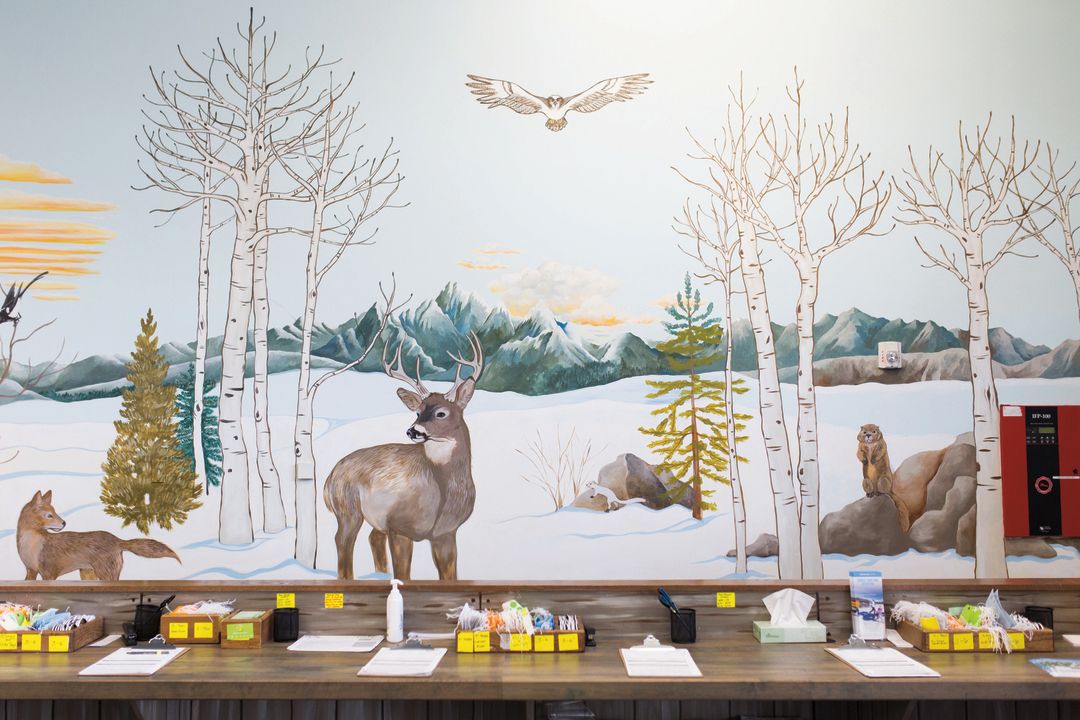The Banksy of Vail Village

Natalie de Stefano outside her home near McCoy
Image: Zach Mahone
Natalie de Stefano may be the most productive anonymous artist in the valley, known yet unknown for the wildlife-themed murals decorating varied public spaces in Vail Village, from the vintage creekscape winding around a ramp of the main parking structure to the scenes of bear cubs, foxes, and other woodland creatures frolicking on the walls of the resort’s ski schools in Golden Peak and Lionshead, which she painted over the summer. Then there are her private commissions, the animated walls and ceilings of vacation homes up and down the valley. So you’d expect to find something special, maybe even spectacular, about the place she calls home, a barnlike structure in the boonies beyond McCoy, 23 miles north of I-70, lost in the scrubland between Vail and Steamboat.
“She’s a hidden treasure,” says her longtime friend Vicki Diveley. “And the house is a mirror of her.”
The exterior of de Stefano’s spread, called Skullbone Ranch, ranges from kitsch to macabre: the facade is decorated with buffalo, deer, and steer skulls, while a flock of pink flamingos, a herd of ceramic horses, and a gaggle of snarling gargoyles have the run of the front yard. Attempting to wipe their feet on the doormat, visitors will realize that it is actually a little trompe l’oeil, or is it a ... wait for it ... matte painting? When de Stefano answers the door, even her outfits reference her namesake home: in her 50s, she’s stylishly dressed in a felt fedora, a Huguenot cross, and a sweater with skulls on it.
Inside, Skullbone Ranch overflows with artworks and photographs and artifacts and knickknacks that tell de Stefano’s story. Watercolor landscapes of her ancestral Alsace-Lorraine, painted in the 1860s by her great-great-grandparents, suggest how deeply art and painting course through her veins. They hang alongside pictures of her dad, Michael, a violinist with the New York Philharmonic for 40 years, and photos of Manhattan, where she was born in 1957, that were taken by her mom, Anne, who made sure Natalie’s childhood was full of music, painting, adventure, and travel.

De Stefano’s mural at the Golden Peak Children’s Ski & Snowboard School
Image: Zach Mahone
Other photos depict her teenage idols: Dylan, Lennon, Allman. De Stefano freely relates stories of concerts, parties, and sightings of famous artists in New York. She talks about leaving home in 1973, at the age of 16, and living the hippie lifestyle in upstate New York, in Connecticut, and on a California beach. A dark, shadowy self-portrait from that time—rendered on the back of a brown paper grocery bag, now ripped like it has been folded and unfolded, carried around roughly—shows a young woman looking away. Her life, she says, was like a roller coaster back then.
Then in 1978, something happened that changed it. She was road-tripping in a Pontiac convertible from Connecticut to Los Angeles with a man—his name isn’t important, she says. One night, she lay asleep in the passenger seat, but woke when the car stopped. She opened her eyes to the most magnificent sight: “kazillions” of stars against a death-black sky. “What is this spot?” she asked her companion.
In 1980, she made that place—this place, with those kazillion stars—her permanent home. She ran the service station in Bond. And she brought her peculiar brand of bohemian art to that sleepy bend in the Colorado River. Diveley, who owned State Bridge in the late 1980s, remembers de Stefano’s arrival: she drove a VW bug and wore feather boas and paint-covered jeans. She pumped gas in a leopard-print bikini. “We called her the Pump Princess,” Diveley laughs.
De Stefano figuratively painted the town: pumping gas, bartending, making a general racket, and occasionally taking her clothes off, says her friend Cass Galloway, who has known her for 30 years. (It was the ’80s in Vail. Nakedness was normal. Well, maybe not normal—but almost. Remember Vail Undressed?) Once the right people got wind of de Stefano’s artistic abilities, she was literally painting the town—creating, among many other things, the sign for the Eagle Police Department, the murals at Fiestas in Edwards and the Minturn Country Club, and the menu at the Turntable.
“I was really happy that I was getting hired to do all this stuff,” de Stefano says. “Back then, I was probably like the only artist in town.”
Galloway hired her to paint, among other things, a mural in every room of her Eagle River Inn; parts of her Big Hat alpaca ranch in McCoy; and the sign for her alpaca apparel shop in Eagle. “It makes people take an interest,” Galloway says. “She’s an absolute original—you just gotta make sure she keeps her clothes on.”
De Stefano has mellowed. She married George Turon; they bought and renovated the house she lives in. “I got this property, and I could finally breathe easier,” she says.
Even as the valley has filled with artists and the resort villages have populated with high-end galleries filled with pricey artwork that’s mostly imported from afar, de Stefano continues to find steady work: the Eagle library, the Vail library, the parking structure at St. James Place, the Uptown Grill, a taco stand, even neighbors’ electrical boxes (to help them blend with the environment). “What haven’t I done?” she laughs.
Though her oeuvre is mostly bright and happy, shadows emerge at Skullbone Ranch. On one wall leans a self-portrait from 2008, with a snarling deathly demon curled around her, an arm folded over her breasts. “Once you have cancer you lose something, and it never comes back,” de Stefano explains. She had always prayed, she says, but never for herself; when she became sick, she retreated into art.
Now cancer-free, de Stefano’s dream is to create a signature gallery of her work, which she wants to build where her property abuts Highway 131. There, she’ll hang art from each decade of her life—not just the playful natural scenes that Vail Village regulars might recognize, but her demons, too, with the gargoyles and skulls. Because that’s just how life is.






































